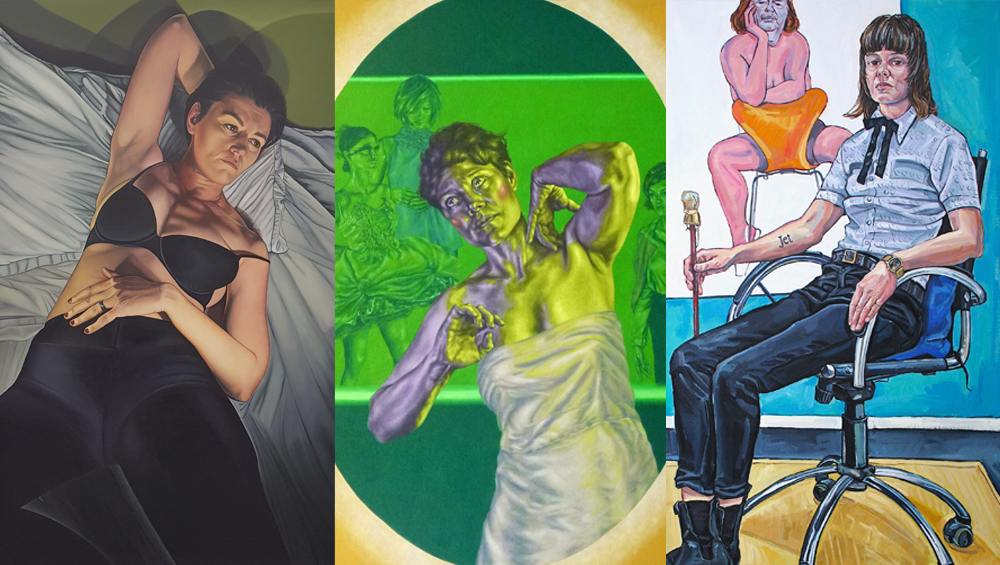
Roxanna Halls by Sadie Lee (left, detail); Sarah Jane Moon by Roxanna Halls (centre, detail); Sadie Lee by Sarah Jane Moon (right, detail). © the artists.
New Art Projects, London
11 January – 4 March 2018
By MK PALOMAR
The exhibitions Threesome (in which three women – Sadie Lee, Roxana Halls and Sarah Jane Moon – paint self-portraits and portraits of one another) and 3X3 (photographic self-portraits by nine queer female artists), displayed in adjoining rooms at New Art Projects in east London, are a collection of images of women by women and curated by a woman. This may sound simple enough: however, in relation to art from the past and the present, and western society seen in the context of the current harassment cases and the #MeToo movement, these images strikingly contest how women have been perceived and are received in our society today.
In this instance, the perception and reception of the female body is layered with sexual preference. Lee explains: “The concept [of the exhibition] was largely based on the fact that we each identified as a lesbian. Apart from being painters, the thing that connected us all was sex.” This contributes a fascinatingly complex mix to the reading of these two exhibitions.
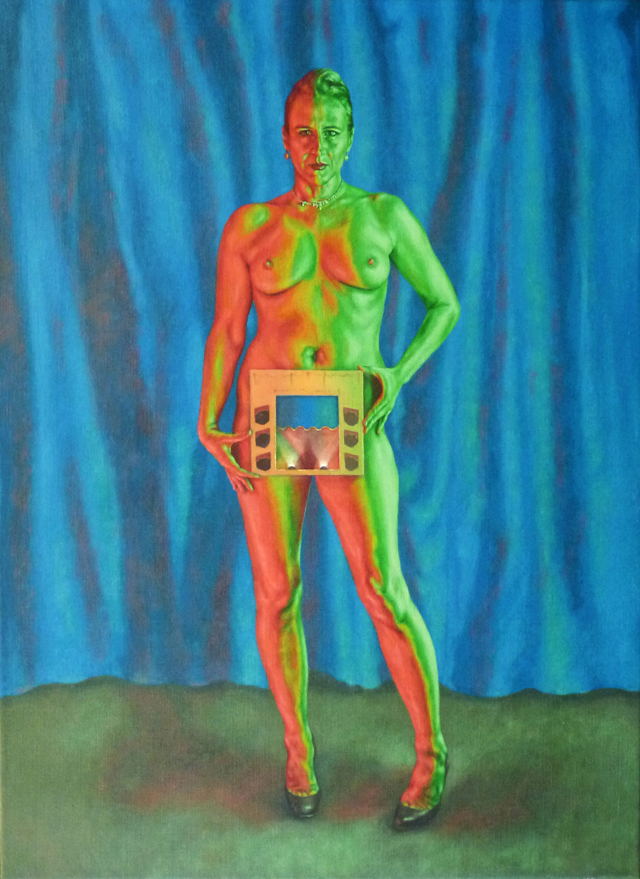
Roxana Halls. Ursula Martinez, 2018. Oil on linen, 80 x 110cm. © the artist.
The art writer and critic Anna McNay was invited to curate Threesome and helped to shape the ideas, find a venue and create the programme, which includes the accompanying photographic exhibition 3X3, for which she devised the concept and selected the artists and their works. McNay explains how Threesome emerged: “With the 50th anniversary [last year] of the Wolfenden report and the partial decriminalisation of homosexuality … there were many exhibitions across the UK celebrating … not least, Tate Britain’s Queer British Art. But the cutoff date for [Tate Britain’s] show was 1967, … so we thought it was timely to pick up from that date and look at works by these three artists Moon, Halls and Lee [all working today].”1
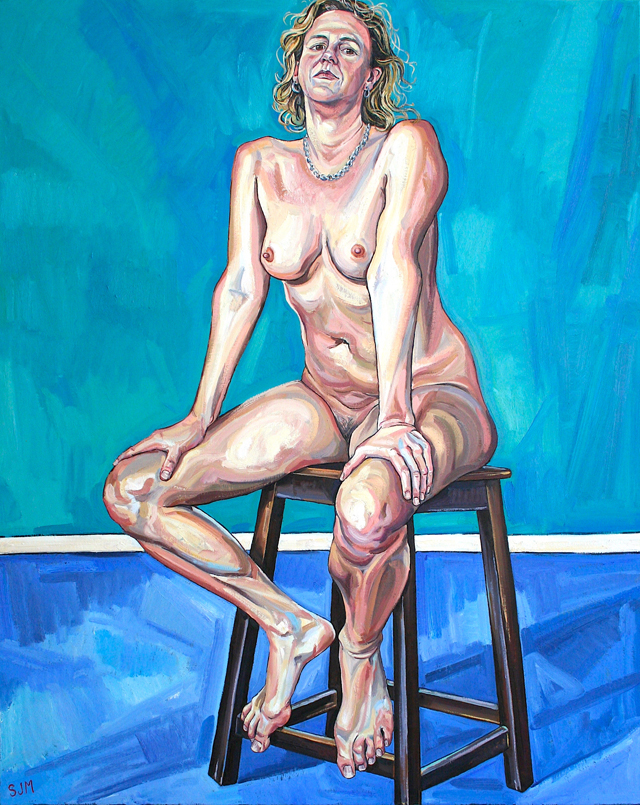
Sarah Jane Moon. Ursula Martinez, 2018. Oil on canvas, 124 x 154 cm. © the artist.
Asked whether she and the artists had anticipated any problems in terms of the reception of the work, McNay says: “We were aware that there is a lot of censorship out there on social media, and also a lot of imagery getting misappropriated and misused.” It reveals a strange and morally confused condition of our times that while soft-porn lads’ magazines are readily available from supermarkets, paintings depicting the female nude are subject to censorship imposed by social media, and often self-selected by the creator to avoid online abuse. It is debatable whether our duplicity in reception is a result of old puritanical dictates embedding the British cultural psyche with perpetual shame around sex, or whether humankind’s imbalanced relationship to sexual desire began once we attempted to become civilised and abandon our wildness altogether. It is interesting to note that in a recent “artistic act”, the artist Sonia Boyce (whose solo exhibition at the Manchester Art Gallery opens next month) removed John William Waterhouse’s 1896 painting Hylas and the Nymphs, intending to “prompt conversation about how we display and interpret art works”.2
McNay continues: “The choice of the title Threesome for the painting show was deliberately provocative, and any eroticism was strictly intentional. We wanted to shake things up a bit, make people question both how they felt looking at these works, and also how it made them look at themselves.”
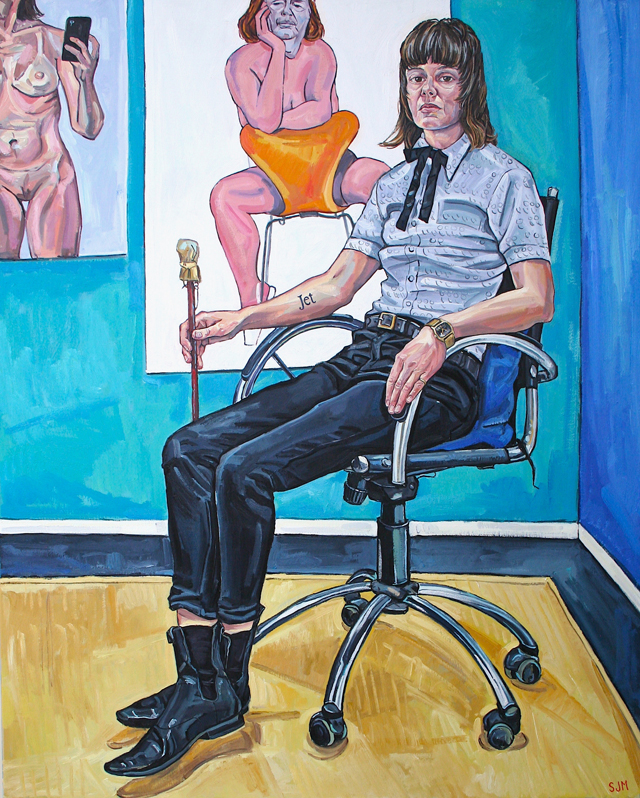
Sarah Jane Moon. Sadie Lee, 2018. Oil on canvas, 124 x 154 cm. © the artist.
Moon, Halls and Lee chose different strategies of composition, pose and placement. Moon focused on the iconic and monumental and, towards this empowerment, set her subjects in their studio and placed different objects of agency in their hands – for Lee a mahl stick, for Halls brushes and for herself a palette knife. Moon’s paintings are deceptively simple; they echo the directness of Alice Neel, each subject looking at the viewer, perhaps proposing a conversation, at least through the gaze – not confrontational but persistent, so that if you were to walk past too quickly they would have you return to wonder what they are proposing.
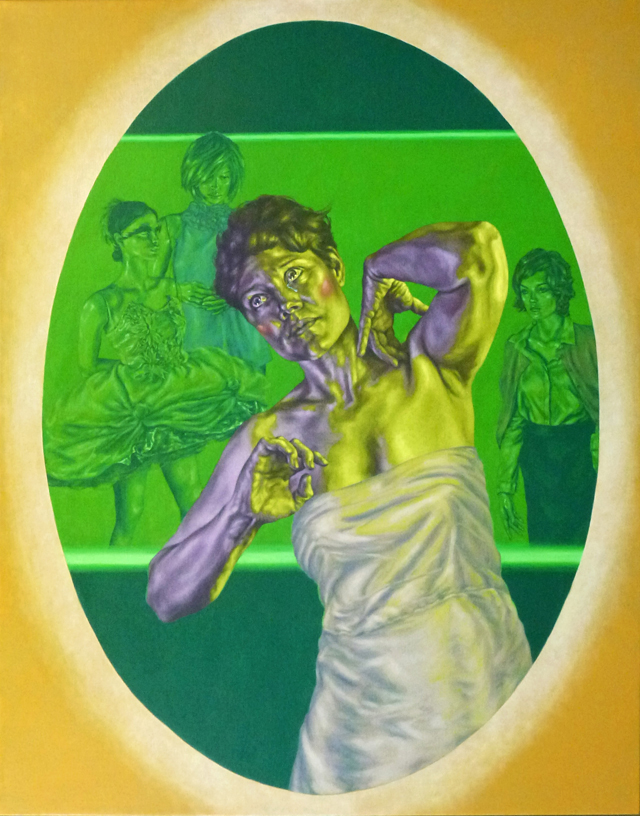
Roxana Halls. Threesome III, 2018. Oil on linen, 110 x 140 cm. © the artist.
Halls says she is examining the “complicated relationship between a male film director’s representation of lesbian characters and how we as gay women, and, of course, I as an image-maker, absorb and respond to such imagery”. She has captured her figures in the throes of a rapturous gesture, psychedelically lit and held in a film-star-shaped frame. She has included in each portrait three accompanying female figures, set back yet posed as though lifted from a film; perhaps these are the subject’s muses.
Lee, “referencing generic images of Venus”, poses her subjects with one arm raised wearing loosely fitted garments (intended to echo the robes covering many painted Venuses). Lee explains: “Venus is traditionally perceived to be the idealised version of femininity and is often depicted looking away, a device intended to make her appear passive, compliant and less confrontational, enabling the viewer to look at her body unchallenged.” Lee directed her subjects (Moon, Halls and herself) “to dress in underwear”. However, she says: “The contemporary nature of hairstyle and modern underwear added a profane suggestion that they had removed their clothes.”
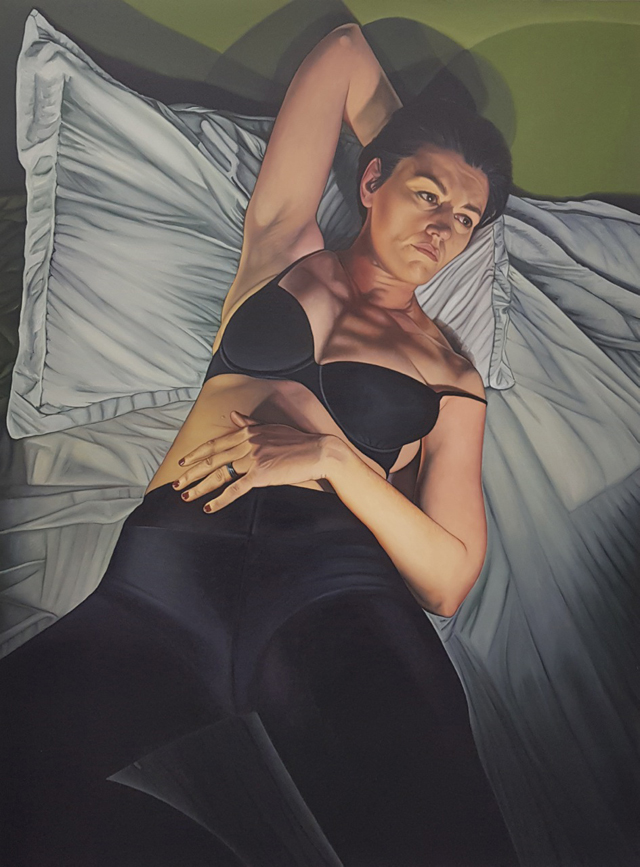
Sadie Lee. Roxanna Halls, 2018. Oil on canvas, 121 x 91 cm. © the artist.
Of the three sets of Threesome portraits, Lee’s paintings are the most erotically charged. It is interesting to note that, as her figures look away, we, the viewers, are placed in the role of the voyeur, to objectify the three women whether or not we want to. Yet, contests Lee: “Despite the vulnerability and tension that this creates, there is also a defiance in the posture. They are aware of the viewer and are giving permission to be looked at.”
Moon, Halls and Lee also give us three nude paintings of the performance artist Ursula Martinez to witness. Halls repeats her filmic theme with mesmeric coloured lighting and by having Martinez hold a frame to focus her crotch; Moon poses Martinez on a stool looking down at us as though at the end of a long day in a life-drawing room; and Lee turns Martinez away to gaze at her crotch reflected in a mirror, and in so doing references Gustave Courbet’s The Origin of the World (1866), Diego Velázquez’s The Toilet of Venus (1647), Ingres’s La Grande Odalisque (1814) and Marcel Duchamp’s Étant donnés: 1° la chute d'eau, 2° le gaz d'éclairage … (Given: 1. The Waterfall, 2. The Illuminating Gas …) (1946-66), and there we (the audience) are voyeurs again, gazing on the figure turned away, left wondering who pulls the strings of power in this gaze.
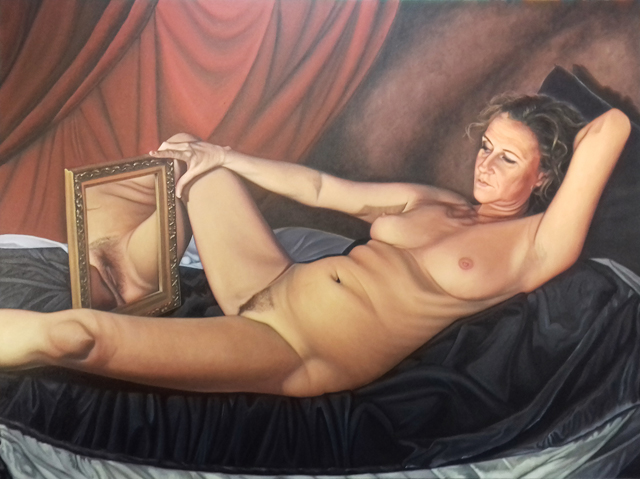
Sadie Lee. The Venus Effect - Portrait of Ursula Martinez, 2018. Oil on canvas, 91.5 x 122 cm. © the artist.
As Charlotte Jansen in her Wallpaper review of this exhibition says, it was feminist film theorist Laura Mulvey who coined the term “female gaze” in opposition to the “male gaze”, while curator McNay, expanding on the ideas of the French feminist writer Hélène Cixous, tells us: “Woman must paint herself, must paint women and bring women to painting, from which they have been driven away as violently as from their bodies. And, to some extent, that is the goal of Threesome.” Such a determined reordering of the power between the observed and the objectified is undoubtedly long overdue and exhilaratingly refreshing to witness.
McNay clarified that having the three painters think about how it was to look at themselves was one of the factors that prompted her to also curate the 3X3 photography exhibition in which: “Nine queer women photographers turned the camera in on themselves to question their own gaze … an experiment in ways of looking, seeing, and being seen … the artists seek to untangle, distinguish, and, in some instances, deliberately re-confuse their own subjectivity and objecthood.”
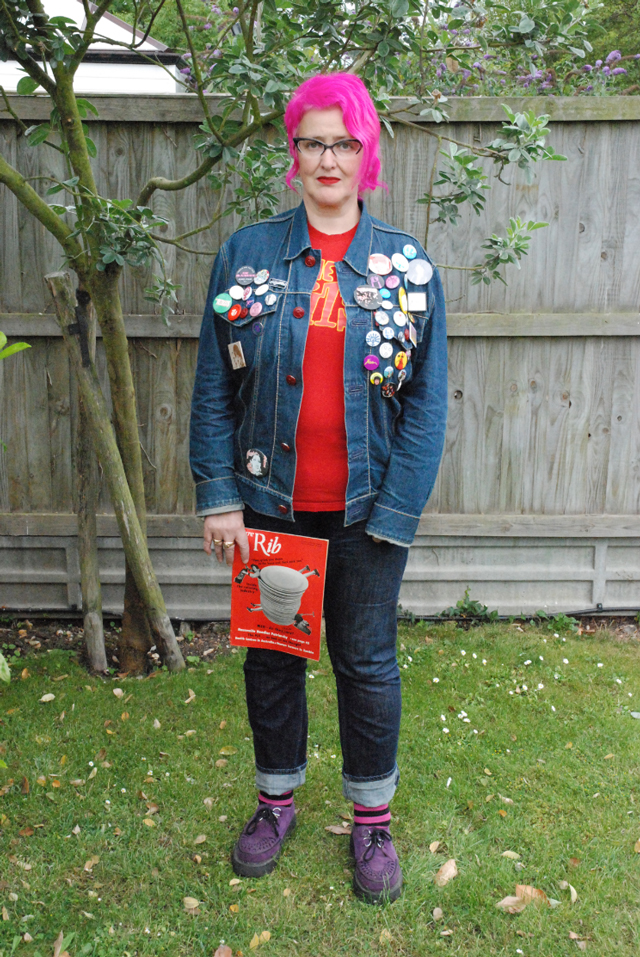
Rachael House. Self Portrait with Badges, after Peter Blake, 2011. Photograph, 83 x 59 cm. © the artist.
Rachael House in her restaging of Peter Blake’s 1961 Self-portrait with Badges, in which he holds a magazine titled Elvis, pays homage to Blake while reappropriating the image by holding a copy of Spare Rib. In Sarah Pucill’s extraordinary Stages of Mourning IX (2000), three heads and multiple hands offer a mesmeric confusion imbued with kindness and care. Each one of the nine self-portraits tell a story while holding a camera to themselves: some look out to us, others look away, each differently shifting the play of their own and the witnesses gaze.
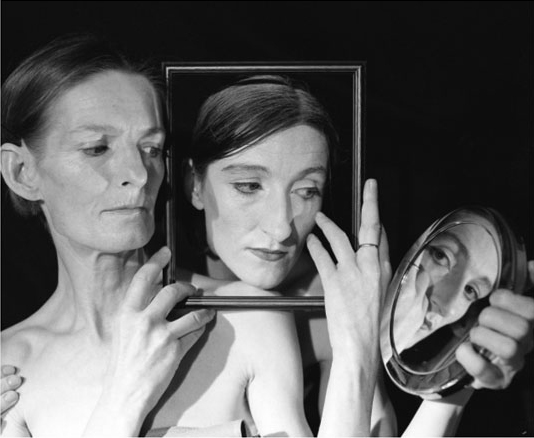
Sarah Pucill. Stages of Mourning IX, 2000. Photographic print from negative, 65 x 80 cm. © the artist.
For those not up to speed with feminist theory and the female gaze, it should be explained how deeply the male gaze is embedded in everyday life, and how regressive its effect is on the female form. If we can know that a racial slur exists in the “darkest” recesses of our prose, then we can also acknowledge the obvious example of the female being “driven away” from all our past stories by recognising that “history”, the word we employ to describe our past, is wholly male gendered. A small thing, yet centuries of forever crediting the male with all of our past, and obliterating the female in all of her roles, has deeply impacted the psyche of today’s western society, profoundly directing perceptions of gender throughout our social and physical environments. It may seem pedantic, perhaps even petty, yet it is part of the framework of our times and one of the ways by which the imbalance between the genders can so freely continue. Sadly, it is not only in language that perceptions are so deeply rooted: images of the female form have long been objectified for the satiation of the passing male.
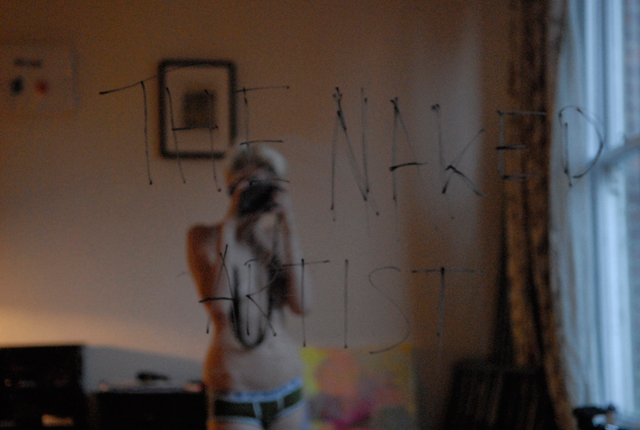
The Naked Artist - Suzie Pindar. Naked, 2015. Photography/mixed media, 54.1 x 84.1 cm. © the artist.
At the ICA’s Philosophy of the Overlooked: Walking symposium, in June 2006, film critic and writer Dr Sukhdev Sandhu stated: “For a woman, the streets are like an extended catwalk where you’re on display.” Despite the blatant subjectivity of Sandhu’s comment, it clearly highlighted the stereotypical male perception of the female in the outdoor place – that women are objects on display for the male. Sandhu’s fellow panellist, the writer Rebecca Solnit, agreed that for females “aged between nine and 25, there was harassment”.3
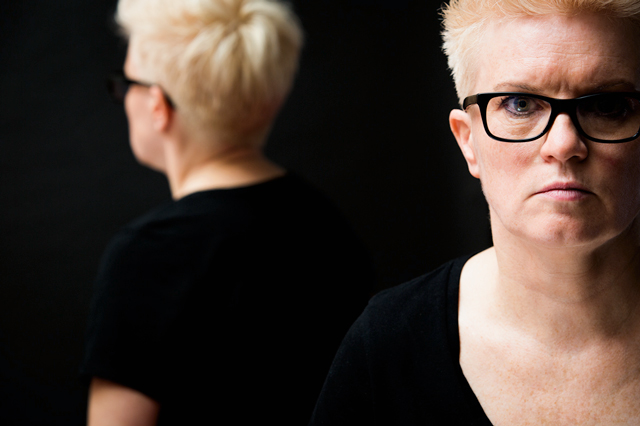
Bronac McNeill. Observe, Examine, Judge, 2017. Digital print on board, 67.2 x 101 cm. © the artist.
In the mid-1800s, the French poet Amantine Lucile Aurore Dupin (AKA George Sand), realised that she could not fully approach or appreciate the outside world as a woman, and so took on a male disguise. In male clothes and boots she “flew from one end of Paris to the other ... No one looked at me, no one found fault with me.”4 Last year, intending “to create awareness about the objectification of women in daily life”, Noa Jansma, a 20-year-old student from the Netherlands, used social media to host her response to the harassment she received from men in Amsterdam. For one month, each time she was catcalled, followed or harassed, Jansma asked the perpetrator if she could take a selfie with him. She then posted the selfie on Instagram. In her first post she explained: “By making the selfie, both the objectifier and the object are assembled in one composition. Myself, as the object, standing in front of the catcallers, represents the reversed power ratio which is [achieved] by this project.” Jansa noted that over the course of the month, only one man asked her why she wanted to take a selfie. “They’re not at all suspicious,” she says, “because they find what they do completely normal.” It would seem, then, given George Sand’s experience and Jansa’s project, that perceptions and receptions of the female body have not moved forward at all in more than 200 years.5 In the light of these examples revealing how deeply embedded and normalised objectification of women is in our society – in language and in behaviour (one directs the other in a continued cycle), we see clearly the troubled and duplicitous landscape in which the images in these two exhibitions (both Threesome and 3X3), are viewed today. And it is astonishing that, despite these multilayered, deeply rooted and complex problems around reception and perception – still these images resonate a steadfast identity sounded with a clear, level voice, determining the viewer to acknowledge her queer identity, displayed and owned tenaciously by both maker and subject.
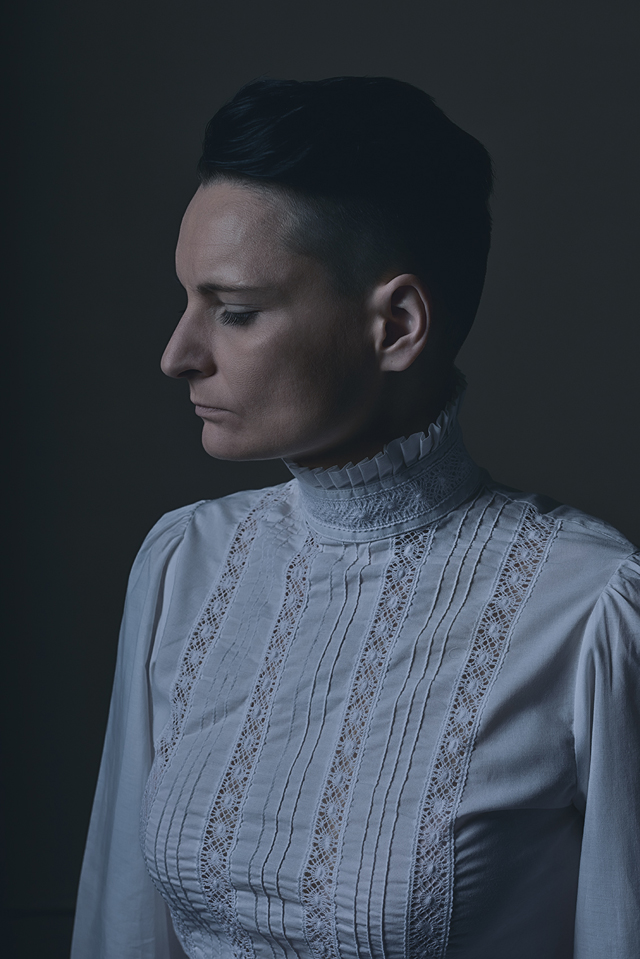
Marta Kochanek. SELF, 2015. Digital photograph, 60 x 40 cm. © the artist.
Is the gaze charged differently when the subject and the maker are of the same interest and gender? Or does the energy of the gaze depend on the interest and the gender of the audience/viewer when receiving the reflected gaze bounced from maker to viewer? There is a refreshing confusion here and something has changed. Is it that gender in some factions of our society may perhaps be on the cusp of becoming more fluid? Or is it simply that a subjective reading of a possible shift in our times is complicating an already multilayered issue? It does appear as though the fourth wall in these paintings has somehow been eased aside – turned around and replaced differently, and, in so doing, a rearrangement of power, desire, curiosity, appetite and refection, have all been shuffled and sorted into a changed state of play. There is a new sort of equality firmly held in the boundaries of these images, a new beginning that I, for one, hope heralds more such brave and refreshing shows.
References
1. Transcribed from an email communication with the author, 31 January 2018.
2. Gallery removes naked nymphs painting to ‘prompt conversation’ by Mark Brown, Guardian, 31 January 2018.
3. Extracts from notes taken during The Philosophy of the Overlooked conference, ICA,
June 2006.
4. The Art of Taking a Walk: Flanerie, Literature and Film in Weimar Culture by Anke Gleber, published by Princeton University Press, 1998, page 172.
5. Majorité Opprimée (Oppressed Majority), 2010, a short film by Eléonore Pourriat.